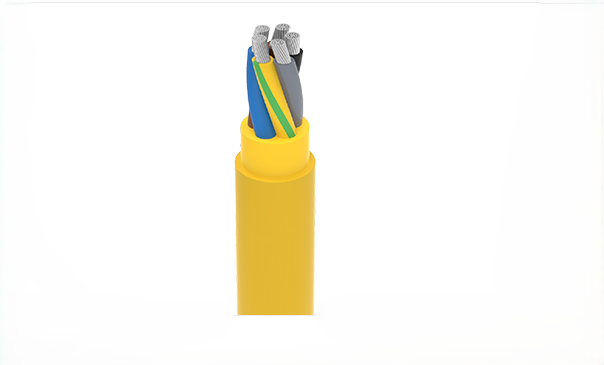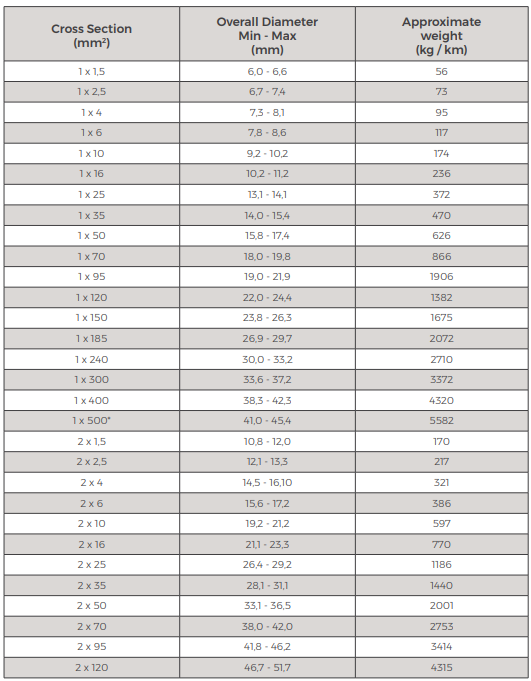Understanding the NSSHÖU Mining Cable
In the demanding world of mining operations, where extreme conditions and unforgiving environments are the norm rather than the exception, selecting the right electrical infrastructure can mean the difference between operational success and costly downtime. The NSSHÖU mining cable represents a sophisticated engineering solution specifically designed to meet the rigorous demands of modern mining and industrial applications. These specialised cables have become increasingly significant in Australia's thriving mining sector, where harsh environmental conditions, from the scorching heat of Western Australian iron ore mines to the challenging underground conditions of coal operations in Queensland and New South Wales, demand electrical solutions that can withstand extreme stress whilst maintaining reliable performance. The NSSHÖU cable series combines advanced materials science with proven German engineering standards to deliver a product that meets the unique challenges faced by Australian mining operations. Understanding the technical specifications, applications, and capabilities of NSSHÖU cables is crucial for mining engineers, electrical contractors, and procurement professionals who need to ensure their operations maintain consistent power delivery in environments where failure simply isn't an option. This comprehensive guide will explore every aspect of these remarkable cables, from their construction principles to their real-world applications across Australia's diverse mining landscape.
5/26/202515 min read
Understanding the NSSHÖU Mining Cable
Introduction
In the demanding world of mining operations, where extreme conditions and unforgiving environments are the norm rather than the exception, selecting the right electrical infrastructure can mean the difference between operational success and costly downtime. The NSSHÖU mining cable represents a sophisticated engineering solution specifically designed to meet the rigorous demands of modern mining and industrial applications.
These specialised cables have become increasingly significant in Australia's thriving mining sector, where harsh environmental conditions, from the scorching heat of Western Australian iron ore mines to the challenging underground conditions of coal operations in Queensland and New South Wales, demand electrical solutions that can withstand extreme stress whilst maintaining reliable performance. The NSSHÖU cable series combines advanced materials science with proven German engineering standards to deliver a product that meets the unique challenges faced by Australian mining operations.
Understanding the technical specifications, applications, and capabilities of NSSHÖU cables is crucial for mining engineers, electrical contractors, and procurement professionals who need to ensure their operations maintain consistent power delivery in environments where failure simply isn't an option. This comprehensive guide will explore every aspect of these remarkable cables, from their construction principles to their real-world applications across Australia's diverse mining landscape.


Applications Across Australian Mining and Industrial Sectors
Mining and Surface Mining Operations
The NSSHÖU cable finds its most demanding applications in both underground and open-cast mining operations throughout Australia. In underground mining scenarios, these cables serve as the lifeline connecting critical equipment to power sources, often spanning considerable distances through challenging terrain. The cables' robust construction makes them particularly well-suited for the constant movement and repositioning required in dynamic mining environments.
In open-cast mining operations, such as those found in the Pilbara region of Western Australia, NSSHÖU cables must contend with extreme temperature variations, dust exposure, and the mechanical stress associated with large-scale earthmoving equipment. The cables' ability to maintain electrical integrity whilst withstanding physical abuse makes them indispensable for powering draglines, shovels, and conveyor systems that form the backbone of modern mining operations.
Underground mining presents its own unique challenges, particularly in coal mining operations where the risk of methane gas accumulation requires electrical equipment that meets strict safety standards. The NSSHÖU cable's compliance with relevant safety standards ensures it can be deployed safely in these potentially hazardous environments whilst providing the reliability needed for continuous operation.
Industrial Areas and Construction Applications
Beyond traditional mining applications, NSSHÖU cables have found extensive use in industrial settings where durability and reliability are paramount. Construction sites across Australia's major cities rely on these cables to provide temporary power distribution systems that can withstand the rigours of construction activities whilst maintaining safety standards.
Quarrying operations, which share many characteristics with mining but often operate in closer proximity to populated areas, benefit from the cables' low-emission characteristics and compliance with environmental standards. The ability to operate reliably in dusty conditions whilst maintaining electrical performance makes these cables ideal for aggregate production facilities and stone quarries that supply Australia's construction industry.
Agricultural operations, particularly large-scale farming operations in regions like the Murray-Darling Basin, utilise NSSHÖU cables for irrigation systems and grain handling facilities where exposure to moisture, chemicals, and mechanical stress requires cables that can maintain performance over extended periods without frequent replacement.
Mobile Equipment Connectivity
One of the most demanding applications for NSSHÖU cables involves connecting mobile equipment that operates under extreme environmental conditions. Mining trucks, bulldozers, and other heavy machinery require flexible power connections that can withstand constant movement, vibration, and environmental exposure whilst maintaining electrical continuity.
The cables' superior flexibility characteristics, combined with their resistance to oil, chemicals, and physical abuse, make them particularly well-suited for trailing cable applications where equipment must move freely whilst maintaining power connectivity. This is especially important in continuous mining operations where equipment uptime directly impacts productivity and profitability.
Electric mining vehicles, which are becoming increasingly common as the industry moves towards more sustainable operations, rely on NSSHÖU cables for charging infrastructure and power distribution systems. The cables' ability to handle both AC and DC applications makes them versatile solutions for evolving mining technology.
Fixed Installation Applications
In fixed installation scenarios, NSSHÖU cables serve as permanent power supply solutions for tunnelling applications, underground facilities, and similar environments where long-term reliability is essential. These installations often involve cables that may remain in place for many years, making durability and resistance to environmental degradation critical characteristics.
Tunnel applications, whether for mining access or infrastructure projects, present unique challenges including potential water ingress, temperature variations, and limited access for maintenance. The NSSHÖU cable's construction specifically addresses these challenges through its multi-layer sheath system and superior environmental resistance.
Underground facilities such as pump stations, ventilation systems, and processing plants require power distribution systems that can operate reliably in conditions where maintenance access may be limited and environmental conditions can be severe. The cables' long service life and resistance to common environmental hazards make them ideal for these critical applications.


Comprehensive Electrical Specifications
Voltage Ratings and Operating Parameters
The NSSHÖU cable series operates with a rated voltage of 0.6/1 kV, which positions it perfectly for medium-voltage applications commonly found in mining and industrial settings. This voltage rating represents the cable's ability to safely handle normal operating conditions whilst providing appropriate safety margins for transient conditions that may occur in industrial environments.
Understanding the maximum permissible operating voltages is crucial for proper application. For alternating current (AC) applications, the cable can safely operate at 0.7/1.2 kV, providing adequate headroom above the rated voltage to accommodate normal system variations and transient conditions. This specification is particularly important in mining operations where power quality may vary due to large motor starting currents and variable loads.
For direct current (DC) applications, which are becoming increasingly important as mining operations adopt electric vehicles and renewable energy systems, the cable can handle up to 0.9/1.8 kV. This higher DC voltage capability reflects the different electrical stresses associated with DC power transmission and the cable's ability to handle these conditions safely.
The test voltage specification of 3 kV represents the cable's ability to withstand electrical stress testing during manufacturing and installation verification. This high test voltage ensures that the cable's insulation system provides adequate safety margins and reliability throughout its operational life.
Temperature Performance Characteristics
Temperature performance represents one of the most critical aspects of cable selection for Australian mining operations, where ambient temperatures can vary dramatically. The NSSHÖU cable's temperature specifications are carefully designed to accommodate the range of conditions encountered in real-world applications.
For fixed installation applications, the cable can operate reliably across a temperature range from -40°C to +80°C. This wide temperature range ensures the cable can function in everything from refrigerated storage facilities to the hot, confined spaces often found in mining operations. The lower temperature limit is particularly important for operations in high-altitude mining areas or cold storage applications, whilst the upper limit accommodates the heat generated by electrical equipment and ambient conditions in Australian mining environments.
Mobile applications present different thermal challenges due to the dynamic nature of the operating environment and the potential for increased mechanical stress at temperature extremes. For these applications, the temperature range is specified as -25°C to +80°C, reflecting the practical reality that mobile equipment typically operates in less extreme temperature conditions whilst still providing adequate performance margins.
Understanding these temperature specifications is crucial for proper cable selection and installation. Cables operating near their temperature limits may experience reduced service life, whilst those operating well within their specifications can provide years of reliable service with minimal maintenance requirements.
Mechanical Performance Parameters
The mechanical properties of NSSHÖU cables are specifically engineered to handle the demanding physical conditions encountered in mining and industrial applications. The bending radius specifications provide crucial guidance for installation and operation, ensuring the cable's integrity is maintained under various mechanical stress conditions.
For fixed installation applications, the minimum bending radius is specified as four times the cable diameter. This relatively tight bending radius allows for efficient routing through confined spaces whilst ensuring the cable's internal structure remains intact. Proper attention to bending radius during installation prevents stress concentrations that could lead to premature failure.
Flexing applications, where the cable experiences repeated bending during normal operation, require a larger minimum bending radius of ten times the cable diameter. This specification acknowledges the cumulative effect of repeated flexing and provides appropriate safety margins to ensure long service life under dynamic conditions.
For applications without forced operation, where the cable may experience occasional bending but not continuous flexing, the minimum bending radius increases to fifteen times the cable diameter. This conservative specification ensures maximum cable life in applications where gentle handling is possible.
The tensile strength specification of 15 N/mm² represents the cable's ability to withstand pulling forces during installation and operation. This specification is particularly important for vertical installations and applications where the cable's own weight creates significant stress.
Insulation Performance
Insulation resistance represents a critical electrical parameter that directly impacts both safety and performance. The NSSHÖU cable's insulation resistance specification of ≥20 MΩ·km ensures adequate electrical isolation between conductors and between conductors and ground under normal operating conditions.
This high insulation resistance value is maintained through careful selection of insulation materials and manufacturing processes that minimise moisture ingress and contamination. The specification is particularly important in mining applications where cables may be exposed to moisture, chemicals, and other contaminants that could compromise insulation performance.
Regular testing of insulation resistance during installation and maintenance helps ensure continued safe operation and can provide early warning of potential problems before they result in failures or safety hazards.







Detailed Cable Construction Analysis
Conductor Design and Materials
The heart of any electrical cable lies in its conductor system, and the NSSHÖU cable employs electrolytic, stranded, tinned copper wire constructed to DIN VDE 0295 Class 5 specifications. This conductor design represents a careful balance between electrical performance, mechanical flexibility, and long-term reliability.
Electrolytic copper provides the highest electrical conductivity available in commercial conductors, ensuring minimal power losses and efficient energy transmission. The stranded construction, as opposed to solid conductors, provides the flexibility necessary for installation and operation in demanding environments whilst maintaining excellent electrical characteristics.
The tinning process, where individual copper strands are coated with a thin layer of tin, provides crucial protection against corrosion and oxidation. This is particularly important in mining environments where cables may be exposed to moisture, chemicals, and other corrosive substances. The tin coating also improves the long-term electrical performance by preventing copper oxidation that could increase resistance over time.
Class 5 stranding, as defined by DIN VDE 0295, specifies the number and diameter of individual strands that make up the conductor. This classification ensures optimal flexibility for installation and operation whilst maintaining the cross-sectional area necessary for current-carrying capacity.
Advanced Insulation System
The insulation system of NSSHÖU cables utilises 3GI3 compound that complies with DIN VDE 0207 Part 20 specifications. This specialised insulation material is specifically formulated to provide excellent electrical properties whilst maintaining mechanical flexibility and environmental resistance.
The 3GI3 compound offers superior dielectric strength, ensuring reliable electrical isolation between conductors and providing protection against electrical breakdown under normal and abnormal operating conditions. The material's formulation provides stable electrical properties across the cable's specified temperature range, ensuring consistent performance in varying environmental conditions.
Mechanical properties of the insulation are equally important, particularly in applications where cables experience repeated flexing or mechanical stress. The 3GI3 compound maintains its integrity under mechanical stress whilst providing the flexibility necessary for installation and operation in confined spaces.
Chemical resistance represents another crucial characteristic of the insulation system. Mining and industrial environments often expose cables to oils, solvents, and other chemicals that could degrade conventional insulation materials. The 3GI3 compound's resistance to these substances ensures long-term reliability and safety.
Protective Sheath Systems
The NSSHÖU cable employs a sophisticated multi-layer sheath system designed to provide comprehensive protection against environmental hazards whilst maintaining mechanical flexibility. The inner sheath utilises special elastomeric compound GM1b, which complies with DIN VDE 0207 Part 21 specifications.
This inner sheath serves multiple functions, including mechanical protection for the insulated conductors, chemical resistance, and moisture protection. The elastomeric properties ensure the sheath remains flexible across the cable's operating temperature range whilst providing robust protection against physical damage.
The outer sheath employs heavy-duty elastomer 5GM5, manufactured to DIN VDE 0207 Part 23 standards. This outer protection layer is specifically designed to withstand the harsh conditions encountered in mining and industrial applications, including resistance to oils, chemicals, abrasion, and mechanical impact.
The two-layer sheath system provides redundant protection, ensuring that damage to the outer sheath doesn't immediately compromise the cable's integrity. This design philosophy reflects the critical nature of power distribution in mining operations where cable failures can result in significant operational disruptions and safety hazards.
Screening and Electromagnetic Compatibility
The screening system employed in NSSHÖU cables varies depending on the specific cable type and application requirements. For 3/E coded types, individual screens made from tinned copper wires are applied over each insulated conductor. This individual screening approach provides excellent electromagnetic compatibility (EMC) performance and reduces crosstalk between conductors.
For other cable types, a concentric overall screen made of tinned copper wires is positioned between the inner and outer sheaths. This screening configuration provides effective electromagnetic shielding whilst simplifying the cable construction and reducing overall diameter.
The use of tinned copper wires for screening provides excellent electrical conductivity for electromagnetic shielding whilst offering superior corrosion resistance compared to bare copper. This is particularly important in mining environments where cables may be exposed to corrosive substances that could degrade screening effectiveness over time.
Proper screening is essential in modern mining operations where electronic control systems and sensitive instrumentation must operate reliably in the presence of high-power electrical equipment. The NSSHÖU cable's screening systems ensure electromagnetic compatibility whilst maintaining the mechanical flexibility necessary for demanding applications.
Standards Compliance and Certifications
Construction and Design Standards
The NSSHÖU cable series is manufactured in accordance with comprehensive German engineering standards that ensure both quality and safety. The primary construction standard, DIN VDE 0250-812, specifically addresses cables for mining and similar applications, ensuring the design meets the unique requirements of these demanding environments.
DIN VDE 0250-1 provides general requirements that establish fundamental design principles and quality standards applicable to all cable types within the series. This standard ensures consistency across different cable configurations whilst providing flexibility for specific application requirements.
The usage guidelines specified in DIN VDE 0298-3 provide critical guidance for proper installation, operation, and maintenance of mining cables. Compliance with these guidelines ensures that cables achieve their designed performance and service life whilst maintaining safety standards throughout their operational life.
Comprehensive Testing Protocols
Electrical testing protocols ensure that every cable meets stringent performance requirements before leaving the manufacturing facility. DIN VDE 0472-501, 503, and 508 specify electrical tests that verify insulation resistance, dielectric strength, and other critical electrical parameters.
Non-electrical testing, as defined by DIN VDE 0472-401, 402, 602, 303, and 615, covers mechanical properties, environmental resistance, and long-term performance characteristics. These comprehensive tests ensure that cables can withstand the mechanical stresses and environmental conditions they will encounter in service.
Fire resistance testing, conducted according to DIN VDE 0472-803 and 804, ensures that cables maintain their integrity under fire conditions and don't contribute to fire propagation. This is particularly important in mining applications where fire safety is paramount.
International Compliance and Recognition
The flame retardant properties of NSSHÖU cables are verified through testing to multiple international standards, including VDE 0482-332-1-2, DIN EN 60332-1-2, and IEC 60332-1. This multi-standard compliance ensures acceptance in international markets and provides confidence in fire safety performance.
Oil resistance testing, conducted according to HD/EN/IEC 60811-2-1 and DIN VDE 0473-811-2-1, verifies the cable's ability to withstand exposure to oils and similar substances commonly encountered in mining and industrial environments.
Environmental compliance through CE Marking, RoHS Directive compliance, and REACH Regulation adherence ensures that NSSHÖU cables meet contemporary environmental standards and can be used in environmentally conscious operations.
Frequently Asked Questions and Technical Troubleshooting
Environmental Performance Questions
Can NSSHÖU cables operate reliably in wet environments, and what specific protections do they offer against moisture ingress?
NSSHÖU cables are specifically engineered to operate in wet environments, including applications where they may be permanently submerged. The multi-layer sheath system provides comprehensive moisture protection through carefully selected elastomeric compounds that maintain their sealing properties across the cable's operating temperature range. The cables can be submerged up to 100 metres in various types of water, including saltwater and contaminated water commonly encountered in mining operations. This capability makes them ideal for dewatering operations, underwater mining equipment, and applications where temporary flooding may occur. The moisture resistance is achieved through the combination of the inner GM1b elastomeric sheath and the outer 5GM5 heavy-duty elastomer, which work together to prevent water ingress whilst maintaining flexibility and mechanical properties.
What flame retardant properties do these cables possess, and how do they perform in fire emergency situations?
The flame retardant properties of NSSHÖU cables represent a critical safety feature for mining and industrial applications. The cables comply with multiple international flame retardant standards, including IEC 60332-1, which ensures they don't propagate flame when exposed to fire sources. The specialised compound formulations used in both the insulation and sheath systems are designed to self-extinguish when the ignition source is removed, preventing fire spread along the cable length. In mining applications, where fire safety is paramount due to the presence of combustible materials and limited escape routes, these flame retardant properties provide crucial time for evacuation and fire suppression activities. The cables also produce minimal smoke and toxic gases when exposed to fire, reducing the risk to personnel during emergency situations.
Chemical and Environmental Resistance
How do NSSHÖU cables perform when exposed to oils, chemicals, and other industrial substances commonly found in mining operations?
The chemical resistance of NSSHÖU cables is one of their defining characteristics, making them particularly suitable for harsh industrial environments. The cables demonstrate excellent resistance to oils, greases, hydraulic fluids, and many industrial chemicals commonly encountered in mining operations. This resistance is achieved through careful selection of elastomeric compounds for both the inner and outer sheaths, which maintain their integrity when exposed to these substances. The oil resistance testing, conducted according to HD/EN/IEC 60811-2-1 standards, verifies performance against specific oil types and concentrations. Mining operations often involve exposure to diesel fuel, hydraulic oil, cutting fluids, and various chemical processes, all of which can be accommodated by properly specified NSSHÖU cables. The chemical resistance also extends to resistance against acids, alkalis, and salt solutions that may be encountered in mineral processing operations.
Mechanical Performance and Installation Considerations
Are NSSHÖU cables suitable for use on cable drums under tension, and what are the limitations for mechanical handling?
NSSHÖU cables are not recommended for use on cable drums under significant tensile loads, as this application can exceed the mechanical design parameters and lead to premature failure. The cables are designed for trailing applications where they can move freely without being subjected to the concentrated stresses associated with drum winding under tension. When cable drums are necessary, proper tension management systems should be employed to ensure the cable experiences minimal stress during winding and unwinding operations. The cables' tensile strength of 15 N/mm² provides adequate capacity for normal installation and operational stresses, but drum applications require careful engineering to avoid exceeding these limits. Alternative cable management systems, such as cable tracks or guided routing systems, are preferred for applications requiring repeated cable movement.
What factors determine the expected lifespan of NSSHÖU cables in various mining applications?
The lifespan of NSSHÖU cables depends on several critical factors, with proper installation and operating conditions being paramount. Under normal operating conditions within specified parameters, these cables are designed to provide many years of reliable service with minimal maintenance requirements. Environmental factors such as temperature extremes, chemical exposure, mechanical stress, and UV radiation can significantly impact service life. Cables operating consistently within their specified temperature range and mechanical limits typically achieve longer service lives than those subjected to extreme conditions. Regular inspection and maintenance programmes can identify potential issues before they result in failures, extending overall cable life. In properly managed mining operations, NSSHÖU cables often exceed ten years of service life, with some installations operating reliably for much longer periods. The key to maximising cable life lies in proper selection for the specific application, correct installation practices, and ongoing maintenance programs that address potential issues before they become critical.




Technical Application Guidance
How should NSSHÖU cables be selected for specific cross-sectional areas and current-carrying capacities?
Proper cable selection requires careful consideration of both the electrical requirements and the environmental conditions of the specific application. The current-carrying capacity of NSSHÖU cables follows VDE 0298-4 guidelines, which take into account factors such as ambient temperature, installation method, and grouping with other cables. For mining applications, it's essential to consider not only the steady-state current requirements but also the starting currents of large motors and the potential for overload conditions. The cable's cross-sectional area should be selected to ensure adequate current-carrying capacity with appropriate safety margins whilst considering voltage drop limitations over the required cable length. Mining operations often involve long cable runs, making voltage drop calculations particularly important for maintaining equipment performance. Professional electrical engineering consultation is recommended for critical applications to ensure proper cable selection and compliance with relevant electrical codes and mining regulations. The comprehensive range of available cross-sections, from 1.5 mm² to 500 mm², provides flexibility for applications ranging from control circuits to main power distribution systems.
Understanding the NSSHÖU mining cable system requires appreciation of the complex interplay between electrical performance, mechanical durability, and environmental resistance. These cables represent a sophisticated engineering solution that addresses the unique challenges of modern mining and industrial operations through careful material selection, advanced construction techniques, and comprehensive quality assurance programs. Their successful application in Australian mining operations demonstrates their capability to meet the demanding requirements of one of the world's most challenging industrial environments whilst providing the reliability and safety essential for continuous operation.
The investment in proper cable selection and installation pays dividends through reduced maintenance costs, improved safety, and enhanced operational reliability. As mining operations continue to evolve towards greater automation and electrification, the importance of robust electrical infrastructure becomes even more critical, making NSSHÖU cables an essential component of modern mining operations.
